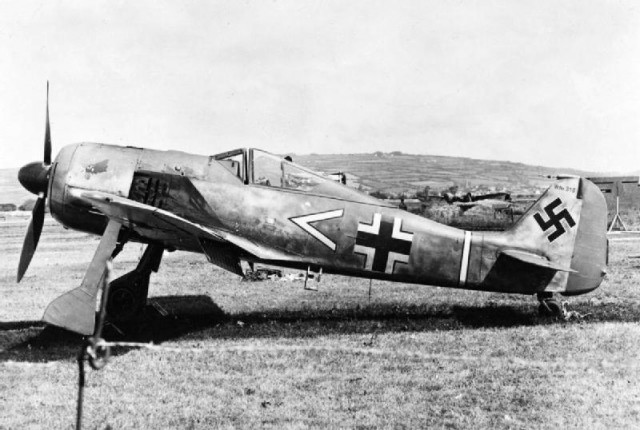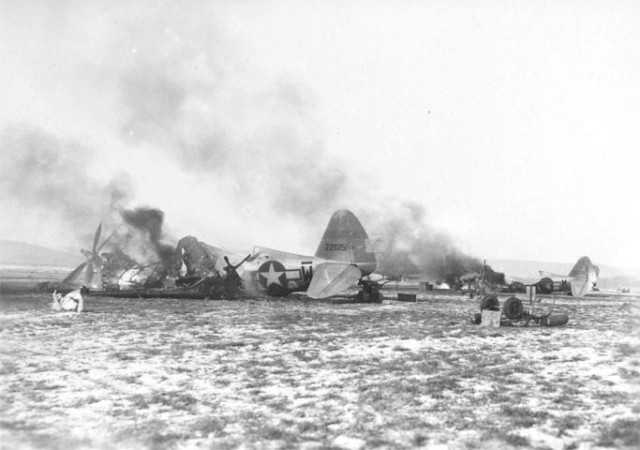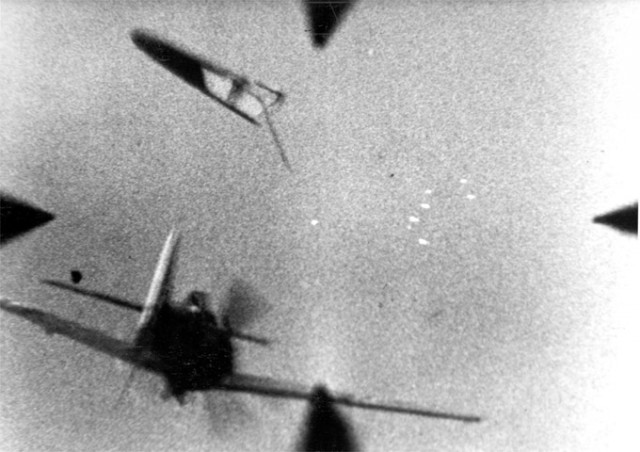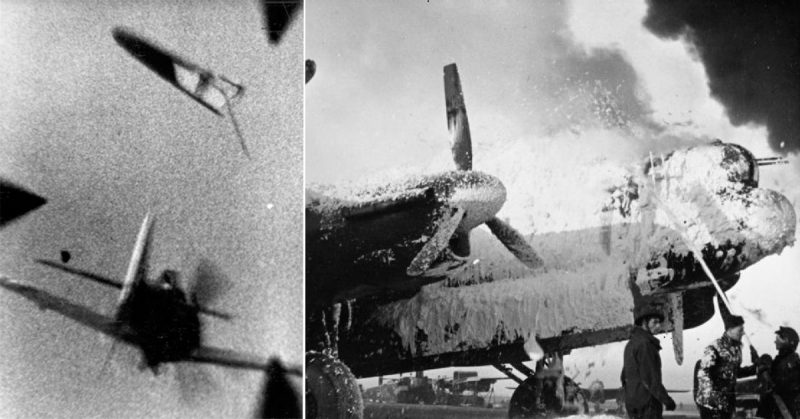For the German Luftwaffe, World War II all but ended on January 1st, 1945 with their last, desperate attempt to strike back against the Ally’s air superiority. After this day, Germany’s skies were quickly lost in the following few months as the Western and Eastern fronts collapsed into Berlin.
Operation Bodenplatte was designed to cripple Allied air power in support of the Ardennes Offensive, or the Battle of the Bulge (December 16th, 1944-January 25th 1945), but bad winter weather pushed back the operation until the first available date, January 1st.
By the time the weather had improved enough for an effective, mass aerial strike like Operation Bodenplatte, the Ardennes Offensive had been stalled by the Western Allies. So this Luftwaffe assault was changed to support Operation Northwind.
Operation Northwind was planned by the Germans as another push on the ground to regain momentum and try, once gain, to split the bulk of the British and American forces in Belgium, the Netherlands, and Northern France.
The Luftwaffe hadn’t been inactive in December 1945, however. They ran what operations they could to support the Ardennes Offensive. Between December 17th and December 27th, over 600 fighters were lost and over 300 pilots killed.
For the second half of 1944, the Luftwaffe had been growing increasingly desperate. Not only had the British been building the Spitfire Mk. IX since 1942 (the first plane to diminish the vast superiority of the German Focke-Wulf Fw 190, which had been outclassing the Ally’s air forces and planes like the Spitfire Mk. V), but the Germans had been losing huge numbers of their skilled pilots while entirely running out of safe training areas for new pilots.

By December of 1944, poorly trained and untested pilots were filling the ranks of the Luftwaffe.
Generalmajor Dietrich Peltz was assigned to lead Operation Bodenplatte by Luftwaffe Commander-in-Cheif Hermann Göring. Pilots from II. Jagdkorps, 3 Jagddivision, and 5 Jagddivision carried it out.
Operation Bodenplatte assigned over 900 German aircraft to attack 16 Allied airfields in Belgium, the Netherlands, and France and destroy their air power. The planes used were the dreaded Focke-Wulf Fw 190A and 190D, and the Messerschmitt BF 109 (which was the most popular fighter aircraft in history, with well over 30,000 frames produced between 1936 and 1945).
Bodenplatte translates into English as baseplate or floorboard. The Germans wanted to drive their boot heels into the foundation of the Ally’s air forces and stomp out their power to support ground troop operations.

Secrecy was a high priority for this mission and several large blunders were made which hampered it from the start due to this. Most pilots weren’t briefed until right before they flew, and many believed they were running a mass reconnaissance mission as they followed their commanders into battle. Pilots were also given maps without their bases or flight paths on them should they fall into enemy hands. This lead to at least one assault on the wrong airfield.
The biggest blow dealt to the operation, by far, due to the German command’s insistence on secrecy was not informing many of their anti-air batteries that the armadas flying overhead on January 1st would be Luftwaffe. As a result, these batteries, like the ones guarding V2 missile launch sites around The Hague, fired on their own aircraft. It is estimated that up to a quarter of the Luftwaffe’s losses that day were from friendly fire.
The attack, at least, managed to catch the British and Americans somewhat off guard. Though only 11 of the 34 air combat Gruppen made their targets on time and the Allies were able to put their planes in the air and mount a substantial defense. Pilots of United States Army Air Force P-51 Mustangs made a huge showing that day in defending their airfields, downing dozens of German aircraft.

At many of the 16 targets the Luftwaffe hit that day, there was a high amount of initial success. At some, few, if any, Allied aircraft were destroyed.
At Melsbroek airfield, just Northeast of Brussels, 35 Royal Air Force planes were destroyed and a further 9 heavily damaged. Jadgdeschwader (squadron) 27 and 54 began the assault with 43 planes. Seven were lost to enemy aircraft and friendly fire before ever reaching the target. By the end of the battle, they had lost almost half their aircraft and 17 pilots were killed or captured.
Many of the battles for the operation had similar results, hurting the Allies, but devastating the already beleaguered Luftwaffe.
It is estimated that Operation Bodenplatte destroyed 305 Allied aircraft and damaged another 190. Although, due to improper records of losses, mostly by the Americans, this figure is challenged and some believe it to be much higher.
Regardless, the operation was far from a success. The Allies lost very few pilots and were well enough supplied in Europe by this point to replace almost all their lost aircraft within the week.
The Luftwaffe, however, lost about 280 aircraft and, more critically, lost many pilots: 143 killed or missing and 70 captured. Among these were many officers, formation leaders and veteran flyers, leaving the few left with crippled resources and often inexperienced pilots for the defense of Germany.
Operation Bodenplatte was, in fact, the last major assault the Luftwaffe was capable of. The war ended 17 weeks later, after the loss of hundreds of more pilots. The boot heel of the Luftwaffe had landed hard on their own foot.
